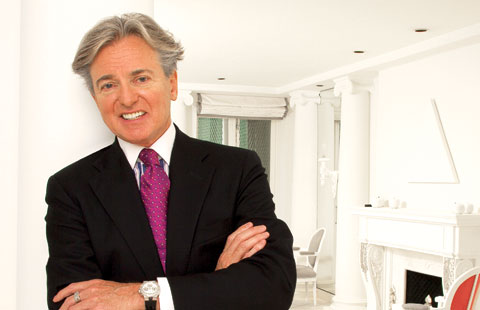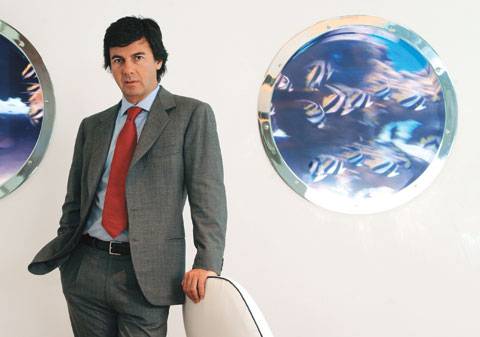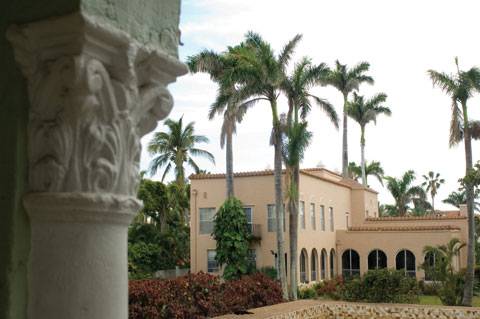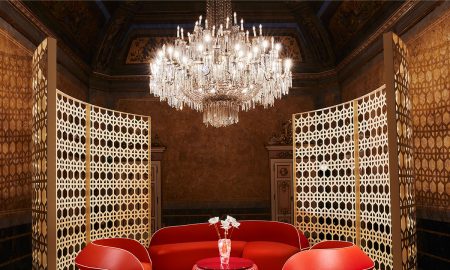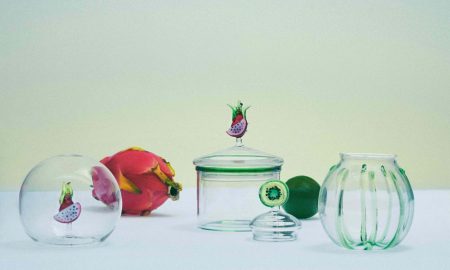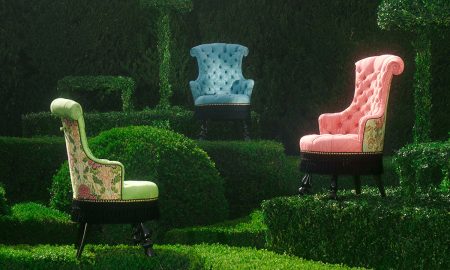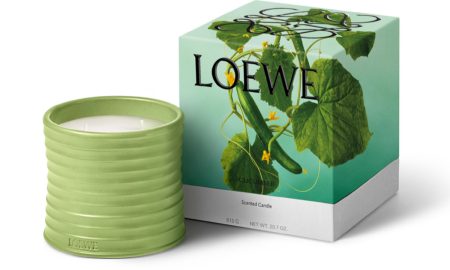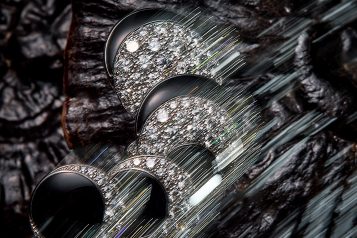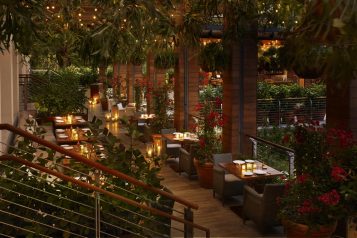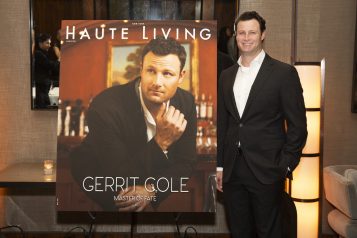Architect Geoffrey Bradfield digs into his latest project, 985 Park, with lots of aplomb and his signature unique flair
By Deborah Morant
In a nod to Louis, and in characteristic aplomb, the living room walls of 985 Park’s apartments will be mirrored in 18-inch squares and the walls of the Moroccan embassy are intermittently lined with mirror.
Park Avenue Geoffrey Bradfieldpersonifies New York. An apartment in a limestone landmark occupying half a block of prime real estate is a prestigious address that embodies luxury and power in the richest city. There’s a thrill about living here, even among the well-heeled residents. The museums, Central Park, salons in the epicenter of elite society, so redolent of prewar New York.
So when a small commercial building was razed and the Icon Group began to erect the first brand-new condominium residence on Park Avenue in years, 985 Park, it was hard to wait to see how the worlds of cutting-edge design and Old World charm could be joined. Costas Kondylis, a maestro architect of the stylishly modern, and Geoffrey Bradfield, a pre-eminent interior designer who stops in for dinner at his friend Prince Charles’ Buckingham Palace residence between photo shoots at country manors for Architectural Digest, were hired to create just seven private residences. Floor-to-ceiling windows are cut into squares to provide an exhilarating sense of light and space, without sacrificing a sense of privacy. The broken expanses of glass and the bird’s-eye views of Manhattan are mesmerizing, with charming views of low-rises and an old church opposite. The architect’s clever addition of glass grids to a building sandwiched between prewar limestone buildings is a respectful solution that does not fight with the Old World feeling of the area, sort of like a facelift that works. Set to open in spring 2007, there are five three-bedroom duplexes, 2,469 square feet apiece, in the $5 million range, and two triplexes, one with a garden and one a penthouse with a terrace, close to 3,000 square feet and priced close to $7 million each.
The sheer size of most of the apartments seems to particularly excite Geoffrey Bradfield. With his first commercial design venture of this scale, there’s no shortage of prestige or superlatives. Geoffrey’s design ethos is easy to buy into: pale-hued rooms as sanctuary, wide-open living spaces. You’re drawn not only to the beauty of the materials he chooses, but also to the feeling of platinum glamour and calm that his spaces exude. Maybe it’s the soft palette, the generously sized rooms that give the spaces he designs such elan. “We were looking for a designer who could capture the classic design of Park Avenue and be more modern for today’s way of living,” explains Reba Miller, marketing director of 985 Park. “Geoffrey is the perfect person to juxtapose those two qualities. His work is very custom and very chic.”
The interiors of 985 Park will mirror those of his own place. Geoffrey’s Upper East Side quarters reflect the unerring eye and unique flair of this renowned South African-born designer. His line of fabrics for Stark debuts in September, a follow-up to his rug collection, with a palette of celadon, pale blues, creams and grays. Patterns are destined to be essential classics, with Art Moderne 1940s references. In the 80s, together with his then partner Jay Spectre, Geoffrey designed more than 16 licensed products, including a silver-leaf dinner set for Sasaki that one can only hope will be reissued with its timeliness and relevance intact. For more than 30 years he has specialized in elegant residences, overhauling the Vanderbilt-Whitney estate in Old Westbury, Long Island, and undertaking the restoration of the late King Hussein’s mansion in Maryland. The Moroccan embassy in New York must be ready before the King arrives at the end of June (“deadlines, deadlines, deadlines,” he notes wryly). His crisp, new line of Lucite furniture, including a “Clear Conscience” coffee table with a loose Louis style, was snapped up by Halle Berry and her new Canadian boyfriend. Of his newly opened office in Dubai, a definitive 21st-century city emerging from the desert, Geoffrey remarks, “It’s nice to be a player there.” And “the ship has sailed,” finally to Mumbai, with bathrooms, kitchen, and furniture containerized for an American executive’s new abode in India. “We had to wait, literally, for the port key there to become available and the containers sat here for weeks. It is Bollywood,” he offers, diplomatically.
Home and office is an 1869 town house on the Upper East Side that was once the lavish residence of an Irishman named McCool. Apt, since the interior’s cool chic is characteristic of Geoffrey, who coined the term “Millennium Modern” to define his work, a design style with great currency. He transforms many of the world’s most exclusive residences with a mix of old and new that defies stereotype. Chopped up over the years into less imposing and homelier configurations, Geoffrey quickly restored the town house layout. Now the supper room, where food and drink would have been prepared for grand soirees, is the ground floor reception area. It was recently borrowed by Bentley for a 21st-century soiree. “I like my work to reflect our time,” he explains. “No matter how divergent the elements are, it should look like 2006.” Bentley liked the parallel between the 19th-century envelope and Geoffrey’s ever-present interior and used it to launch their latest vehicle.
The reception area’s twin Louis XVI chairs are backed in bright pink, discreetly so since the pop color is only visible reflected in mirrored wall panels. Two Ming vases contrast with a graffiti ball by an emerging artist, Yuri Zatarin, perched on a Lucite table designed by Geoffrey. These segue to a mirrored courtyard with a large bronze sculpture by Joel Perlman, whose work is also in the Metropolitan Museum. In a room with twelve classic Iconic columns and Jean Cocteau’s art moderne wall sconces from Beauty and the Beast fastened to the mirrored walls, brilliant halogen floor lights and disguised speakers bring the room to au courant levels of light and sound. “Technology changes at such a clip, it’s almost hard to keep up with. You can’t ignore the in-your-face impact of it has,” enthuses Geoffrey.
Integration of modern technology is key for this designer. But with an interior designer’s knack for obscure and historical references, he recalls passages from The Essence of Style, a highly readable book that reveals, in fascinating detail, some of the reasons for the French superiority complex. “Chapter 9 was written for me,” he notes, smiling. Twenty-three pages of small print devoted to Power Mirrors, a Geoffrey signature. Fed up with spending more than $1 million a year in the 1660s for about 400 mirrors, the Sun King literally stole Venetian mirror makers and in the first decidedly hostile takeover assumed control of the industry. “Louis XIV created the Hall of Mirrors at Versailles. Prior to that, no interior with mirrors existed. He made mirror into the most glamorous element in the room. He galvanized style. We may not like the Gauls, but their culture is infinitely chic,” notes Geoffrey, a fan of the King who, he notes, braved battle equally well on the field.
Mirrors, flanking the fireplace and the garden’s lattice panels, also delineate the library bar upstairs, all allowing for an elaborate play of light and space. Reflected in each looking glass is Geoffrey’s august and impressive collection of modern art. In fact, the organizers of Art Basel, Miami’s premier modern art show, recommended his latest book, Defining Millennium Modern, simply for its use of modern art in interior design. Geoffrey started his art collection at 21 in 1969 and is constantly expanding it. “My philosophy has always been to buy one good painting a year, and within five years you’ll have a collection. Buy the best you can afford.” At 21, a flower child with hair on his shoulders and an earring dangling from one ear, he walked into a Johannesburg art gallery. “The art dealer must’ve thought I was crazy. I bought a tiny Miro drawing. It took me a year to pay it off.” The way he framed it explains his remarkable consistency. Two thick slabs of clear acrylic frame the small drawing suspended in the middle, with large silver screws piercing through and fastening the frame at each corner. It stands, his talisman still, on his mirrored bar, a paen surrounding it.
The designer counterbalances an austerely monochromatic palette of white, mirror, lucite and soft grays and a restrained sobriety in the furnishings -simple, clean lines and largely subdued colorations – with small pockets of embellishment and dense, rich pattern and color. These come in enviable art and ceramics, including a Louise Nevelson and the ceramic Faberge eggs the Tzar actually used for his children’s Easter egg hunts.
Throughout the residence, the most remarkable names in 20th-century art can be found: Cocteau and Poillerat keep company with Giacometti (andirons), Ruhlman (a pair of chairs with silver jabots that need regular polishing), Lalanne, Milton Avery, and Yves Klein. On a Louis XV desk is a Jonathan Adler multi-face vase, iconic now, that goes with blanc de chine pieces that are several hundred years old, including a ceramic elephant that has a twin in the Duke of Chatsworth’s house. Geoffrey’s Lucite wing chair and coffee table are surrounded by plush, tufted upholstered sofas and shelves lined with books.
On the cusp of the millennium, he aligns traditional with Julian Schnabel’s “Icaris” series (“also collected by Sir Elton John in his palazzo in Venice”) and an incredible, museum-quality coffee table, by Yves Klein, of cobalt-blue powdered paint encased in acrylic (“purchased from Sotheby’s when one could”). Guests are encouraged to make a wish while holding the Bluebird of Happiness by Francois Lalanne, whose work Geoffrey has collected for years. (Thirty years before, the Sunday New York Times anointed them “huge news.”) Lalanne’s sheep herd in the living room in his Palm Beach home. “It’s great that they are suddenly so in vogue. It’s a nice endorsement,” he notes. Geoffrey champions new and old craftsmen, but without the rustic connotations.
The halls, like the powder room, are lined in faux shagreen with nailhead trim, so as to feel upholstered. Classical orchestral music is piped in.
In a nod to Louis, and in characteristic aplomb, the living room walls of 985 Park’s apartments will be mirrored in 18-inch squares and the walls of the Moroccan embassy are intermittently lined with mirror. Neoclassical moldings enable both the 19th-century residence and the new apartment building to mesh into the neighborhood’s context and remain youthful and of the moment. The embassy will be dotted with French antiques, in keeping with both that country’s heritage and with the limestone mansion. In Bradfield style, large black and white canvases by contemporary Moroccan artists have been commissioned to bring in the 21st century. At 985 Park, entrée comes through beautiful iron gates designed by Geoffrey, inspired by the work of Gilbert Poillerat. “They’re dramatic and give the building a uniqueness without making it the orphan child.” Pale gray marble floors will line the lobby, whose entire south wall is to be mirrored. A Louis XV desk, a sister to the one in his library, will preside, with coffered ceilings and plaster moldings overhead. “It’s rich without being in your face.” There will be a wonderful sense of procession as you enter the building.
Though his work is global, Geoffrey is profoundly a New Yorker. “There is nothing like a convert,” he states. “I’m totally Stars and Stripes. When you work in London, before you even finish your sentence you hear ‘It can’t be done, it can’t be done.’ In America, certainly New York, you can get a grand piano up to the 60th floor and in through a window. They get out their calculator and they give you a price. I love that kind of thinking.” Perhaps because it mirrors his own.







